Oh yes, this recipe was a real treat to make.
It wasn’t a total surprise that it would be, though. Generally, when you come across a recipe that has been called a “wonder,” then you can safely expect the outcome to be quite enjoyable.
And yes, for arroz de marisco, it more than lived up to the billing.

The 7 Wonders of Portuguese Gastronomy
You must be curious what exactly we mean when we say that arroz de marisco is a “wonder” recipe.
When we first came into the recipe, we were too. Any website we found – both in Portuguese and in English – referred to the “7 Wonders of (Portuguese) Gastronomy,” an illustrious group to which arroz de marisco belonged.
Upon further digging, we found out that there was a special contest held in 2011 in the Portuguese city of Santarém to determine which seven dishes were the most absolutely invaluable to the rich tapestry of Portuguese culinary history.
With the identification of the nation’s food culture at stake, the event organizers certainly did not tread lightly with the contest’s rules. To even be nominated for the contest (only 70 or so dishes were in the end), each recipe had to be distinctively Portuguese and have a “proven track record” of being made within the country.
The event’s site even listed out 7 key criteria each recipe needed to pass for nomination. Each recipe had to:
- Be well-aligned with traditional Portuguese cooking values
- Have a documented history of at least 50 years, or before 1960
- Be actively cooked and made within the country
- Made with ingredients and produce native to Portugal at the national level (if not regional or local)
- Draw inspiration and/or reference from one or more regional Portuguese diets
- Support the biodiversity and/or the culture of one or more regions
- Represent a progression and enrichment of a region’s gastronomical influence
Whew! With such stringent (and elaborate) criteria, it’s hard to imagine how many recipes didn’t make the cut for this particular event.
As one of the few that did, arroz de marisco clearly already held a special place in many a Portuguese heart… even as such a young recipe.
How Arroz de Marisco Came to Be
The creation of arroz de marisco came only 40 or so years ago at the hands of a man named Adelino Coelho. As a young man, Coelho moved to Praia de Vieira for a job to restore the beaches over a half century ago. After 12 years of living in the area, Coelho opened his own restaurant named Solmar and sought to create a recipe that would have people coming back to the area at all times of the year.
It was through this pursuit that arroz de marisco came to be. Not only did Coelho succeed in making a recipe to be enjoyed year-round, but it actually became a tourist attraction for the area in and of itself!
Soon, other restaurants in the area began serving their own versions of arroz de marisco. Then restaurants in other regions began serving arroz de marisco. It wasn’t long before the dish “went viral” in a pre-internet time and became a nationwide sensation.
Et voila, it has ascended to be one of Portugal’s 7 Gastronomic Wonders.
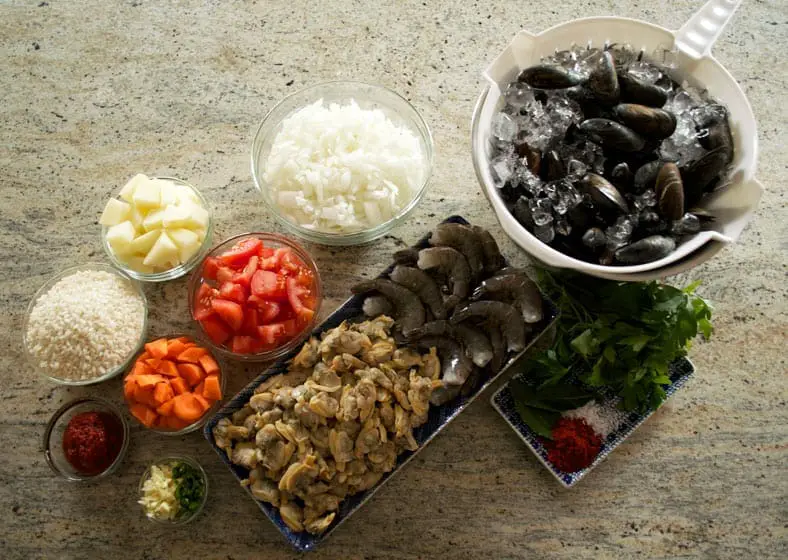
About the Recipe
It’s easy to ascribe arroz de marisco as similar to a Spanish paella or an Italian risotto, but that would be misleading and insufficient to the beauty of this recipe.
The key to a distinctive arroz de marisco is to have rice cooked for a sticky, moist texture amid a fish stew. You can very reasonably expect to add ample amounts of broth or fish stock as you go along.
If you were to start from square one and make everything from scratch (we did for the most part), arroz de marisco can take you a reasonable amount of time. Granted, it will be time spent in a very enjoyable and leisurely way, but there are several steps that should be done in sequence… even if it means slowing the entire process down.
The first step would be to steam and pre-cook your shellfish. With the occasional exception of a few mussels and clams still in their shell, it’s most convenient for the eater if the meat has already been pre-extracted from the shell. When doing so, however, it’s really important to keep the cooking juices intact since they’ll also make their way into the final cooking stockpot as well.
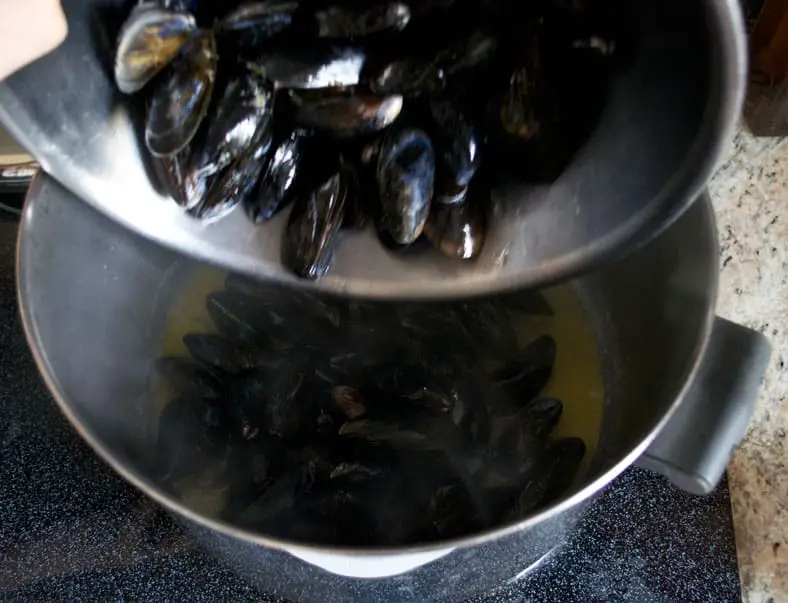
Next, you’ll want to take leftover shells and/or shrimp shells along with any other leftover green stalks and create a seafood broth. The broth you use and its flavors are key for the overall outcome of your arroz de marisco, which is why most recipes we encountered suggested making your broth homemade with the seafood procured for the recipe.

With the stock made, it then becomes a fairly easy process to pre-cook your vegetables before adding your stock, to which you then add the rice to cook and absorb a decent amount of the stock liquid. Since the end-goal is to have a stew-like consistency, though, you should be sure to have the liquid outpace the amount the rice can absorb.
Over the course of cooking the rice, simply add your seafood at the appropriate times so that they don’t overcook. Once all is cooked and the recipe nearly finished, simply take the stockpot off heat and add fresh cilantro to the mix, and you’re done!
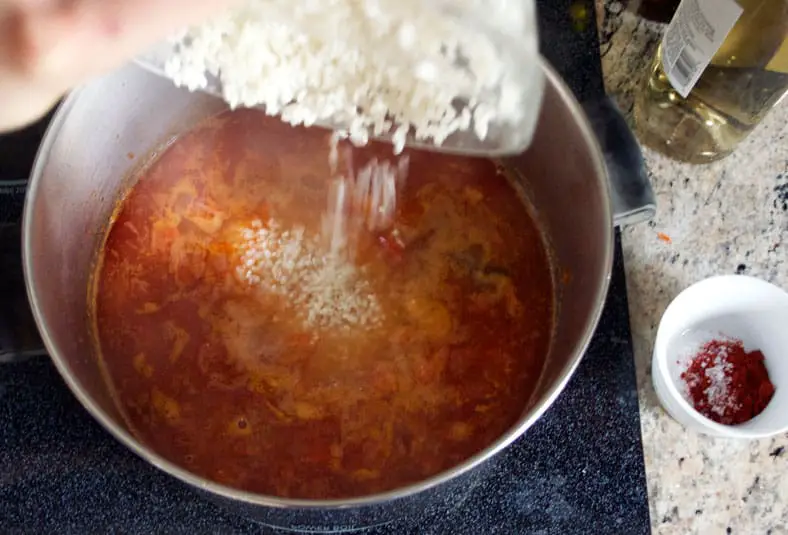
Our Take on the Recipe
Using our original reference recipe as a base, we did make a few additions and adjustments to the recipe.
For starters, since arroz de marisco is intended to have rice that develops a risotto-type texture as it cooks, we used arborio rice in the absence of the original recipe specifying a specific type.
With regards to the other ingredients, we added potato and carrots to our version of arroz de marisco. We saw an even split of recipes that did and didn’t include these filling ingredients (since it is a very robust dish as is), but we personally enjoyed having the added textures and flavors present. It’s completely up to your personal tastes, though, and is just as tasty without them as it is with.

Finally, perhaps our most conspicuous adjustments came in the seafood area. While we tried to find good crab and clams in their shells around our area, we didn’t find any that really wowed us at all. In our particular case, we ended up forgoing the crab altogether and opting instead for pre-extracted clam meat. Our personal preference would have been to find as fresh and high quality seafood as possible (and you should if you can in your area), but for us it unfortunately wasn’t meant to be.

In the end, though, arroz de marisco is a “wonder”-ful and simple recipe packed with delicious sea flavor that is indeed perfect to be eaten year-round.
Have you tried the “Wonder” arroz de marisco? Comment below!
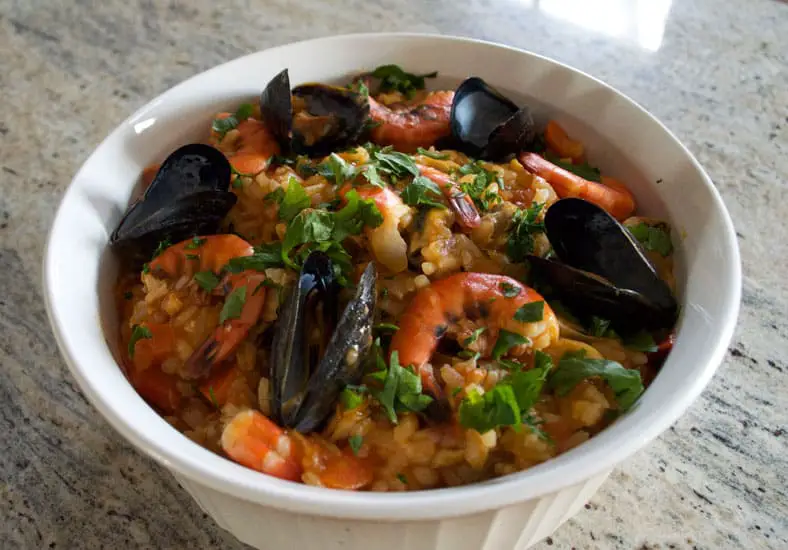

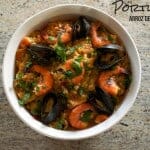
Arroz de Marisco
- Total Time: 50 minutes
- Yield: 6 people 1x
Description
Arroz de Marisco in butter and virgin olive oil.
Ingredients
- 1 tablespoon of butter
- 1 pound of clams
- 1 pound of shrimp
- 1 pound of mussels
- 3 tablespoons of extra virgin olive oil
- 2 cloves garlic, minced
- 1 medium yellow onion, finely diced
- 1 bay leaf
- 2 tablespoons tomato paste
- 2 ripe tomatoes, cubed
- 2 medium carrots, cubed
- 2 medium yellow potatoes, cubed
- 1 small green chili pepper, deseeded and diced (optional)
- ¾ cup white wine
- 4 cups fish or seafood or vegetable broth (this is a great time to make homemade seafood stock with leftover shells and green stems, etc)
- 1 teaspoon smoked paprika
- 1 teaspoon sea salt
- 1½ cups arborio rice, pre-washed
- 1 handful of fresh coriander
- salt to taste
Instructions
Stage 1
- Bring a stockpot over a medium-high heat and heat the butter
- As the butter starts to melt and sizzle, add ¼ cup of white wine and up to ¼ cup of fish stock. Let the liquid come to a slight bubble or boil
- Once bubbling, add your mussels and clams to the stockpot and cover it. (Note: only add if your seafood is still in its shell. If you bought just the meat for one or the other, don’t add it to the stockpot)
- Keep the stockpot covered and let the mussels and clams steam for ~10 minutes. They will open up and can later be easily removed from their shells
- After 10 minutes, take the stockpot off the heat and pour your shellfish into a colander and bowl. Keep and collect the wine/butter/shellfish juices in the bowl… they will be a delicious addition to the arroz de marisco
- Remove most of the shellfish from the shell and set aside
Stage 2
- Take the stockpot back to over medium-high heat and add your olive oil
- As the bottom of the pot starts to heat, add your onions, garlic and bay leaf. Stir around for 2-3 minutes as the onions start to sweat
- Next, add your tomato paste and stir well into the oil and the ingredients. Stir around for another 1 minute
- To deglaze and create the base for the stock, add your white wine and stir well through
- After another 1 minute, add your carrots, potatoes, tomatoes and chili pepper. Stir for 1 minute
Stage 3
- With all vegetables in and cooked together, now add your fish or seafood broth and submerge the ingredients.
- Add your smoked paprika and salt and stir well. Bring your stock to a boil
- Once the stock is boiling, add your rice. Let boil and cook for 5 minutes together. If you see it becoming too dry in the stockpot, add extra broth as needed. You want to have a semi-liquid consistency
- After 5 minutes, reduce the heat to a simmer and cook for another 7 minutes
Stage 4
- After 7 minutes, add your shrimp and cook for another 3 minutes
- Add your clam and mussel meats to the arroz de marisco. Cook for another 1 minute before removing the stockpot from the heat
- Before serving, mix the coriander into the rice, and serve!
- Prep Time: 20 mins
- Cook Time: 30 mins
- Category: Entree
- Cuisine: Portuguese


What a beautiful dish! Our family loves seafood…I can’t wait to try this!
Let us know how it goes for you Michelle! It’s so worth making 🙂
I have been craving a seafood rice dish for several weeks! I’m loving this recipe, Pinning to make ASAP!
That’s so great to hear, Gwen! Let us know once you’ve had a chance to make it 🙂
We’re huge fans of seafood and stews made with fish and seafood, so this sounds like a real winner to me. I’m familiar with cioppino and bouillabaisse in various iterations, but have never had arroz de marisco. The use of short grain rice (like paella) is enticing. One question though – I noticed that one of the criteria for being considered in the 2011 contest was that the recipe had to be at least 50 years old. But you began the story of arroz de marisco stating that it was invented 40 years ago. So how did it qualify for consideration in the contest? by the way, if you want to look for the more authentic rice and also get great fish stock and spices from Spain and Portugal in the DC area – try A&H Seafood in Bethesda. It used to be a hole in the wall – they’ve fixed it up some, but the stuff is still great and it’s the retail outlet for a wholesale operation, so the fish is usually very fresh. http://www.pescadeli.com/about-us.html
Laura, it’s funny you ask that, since it was something we asked ourselves in the research for this post. Technically, Adelino Coelho moved to Praia de Viera in 1961 but didn’t open Solmar until 1973. It was through Solmar that the dish became as rabidly popular as it did, but that’s not to say that it might not have been “invented” per se earlier than that.
It could also be that the dish was just so popular that the judges of the competition decided to be a little lax on that particular criterion for arroz de marisco.
At least those are two possible theories we came up with over here, although we really don’t know which one might be the more plausible one…
Awesome tip about A&H by the way. We’ll definitely check it out 🙂
Anything with rice always catches my attention! I have made the Spanish Paella and so want to try this Portuguese arroz, too! Yum!
They’re very closely related, Manila Spoon, so if you like paella then you’ll certainly like arroz de marisco. I might be a bit biased by now, but I do find arroz de marisco to actually have a few intricacies not seen in many paellas